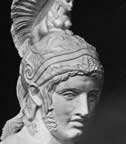Origin of the Months and Days of the Year
We use them everyday to order our lives to record, analyse and make sense of things. We are of course talking about the days and months of the year. So what are the origins of the names and terms we use. You may be surprised in that they all have origins deep within our pagan past …
The Days of the Week
The Days of the week all have either Roman, Anglo-saxon or Norse origins …
| Monday | : | Named after the Moon who in Norse tradition was the Goddess of hunting. She wears a white robe and carries a bow and arrow. |
| Tuesday | : | Named after Tiw Norse God of war. He dresses like an Anglo-Saxon warrior and carries a battle-axe. |
| Wednesday | : | Named after Woden, also know as Odin, chief among all the gods. He dresses like a king and carries a spear to show his authority. |
| Thursday | : | Named after Thunor, also know as Thor the god of thunder. He dresses like a warrior and carries a bolt of lightening. |
| Friday | : | Named after the beautiful Freya the Goddess of love and the wife of Woden. She carries no symbols because she is said to be so beautiful and requires no adornment. |
| Saturday | : | Named after the Roman god Saturn the god of fun and feasting. He is appropriately fat and jolly. |
| Sunday | : | Named after the Roman god of the Sun, Solis god of life. He is often depicted as a youth with a sun halo. |
The Months of the Year
| January |
The god Saturn bestowed upon Janus this ability to see into the future and past at the same time His name comes from the Latin word ianua, which means “door.” And thus Janus is the god of doors, gates, doorways, bridges, and passageways, all of which symbolize beginnings and ends. Janus was also used to represented transition, such as the time between youth and adulthood. |
| February |
One interesting linguistic story, though, lies in England. Before we adopted the Latin name for the second month, Old English used much more vibrant names to describe it. The most common Old English name was Solmonath, which literally means “mud month.” It is pretty clear what they were describing. A lesser-used term was Kale-monath, which meant “cabbage month.” We can imagine that the English were eating a lot of cabbage in February in the 1100s. |
| March |
The Ides of March is a reference to the date Julius Caesar was stabbed to death in 44 B.C. and is observed on the 15th day of the month. |
| April |
Prior to the addition of January and February by King Numa Pompilius around 700 BC, April was the second month of the Roman calendar year – March being the first. Around 450 BC, April slipped into the fourth slot and assigned 29 days. With the introduction of the Gregorian calendar by pope Gregory XIIII in 1582, an extra day was added and thus ‘30 days hath April.’ Though April’s derivation is not certain, a common theory is that the name is rooted in the Latin Aprilis which is derived from the Latin aperire meaning “to open” – perhaps a reference to the opening or blossoming of flowers and trees, a common occurrence throughout the month of April. Another theory holds that since months are often named for gods and goddess and since Aphrilis is derived from the Greek “Aphrodite,” one can surmise that the month was named for the Greek goddess of love, whom the Romans called Venus. Around the 5th century AD, the Anglo-Saxons referred to the month of April as Oster-monath or Eostre-monath, a reference to the goddess Eostre, whose feast occurred during this month. The Venerable Bede, a monk from the Northumbrian monastery of Saint Peter, believed this gave root to the word Easter – most often observed during the month of April. |
| May |
But the Romans had yet another goddess named Maia, who just happened to share a name with the Greek goddess. The Roman Maia was named for the Latin word for large, “maius,” and she was associated with growth and the spring. As the Romans adopted many elements of Greek culture, the two goddesses became conflated and gave their name to the fifth month. However, there is another suggestion that the month is not named for these intertwined goddesses at all. The Latin poet Ovid claimed that the month may have been named after the Latin word “maiores” which meant “elders” to juxtapose it to the month of June, which was named for the youth, the Latin word “iuniores.” |
| June |
June is the month with the longest daylight hours of the year in the Northern Hemisphere and the shortest daylight hours of the year in the Southern Hemisphere. June in the Northern Hemisphere is the seasonal equivalent to December in the Southern Hemisphere and vice versa. In the Northern hemisphere, the beginning of the meteorological summer is 1 June. In the Southern hemisphere, the beginning of the meteorological winter is 1 June. |
| July |
Julius Caesar (as in kaiser and many other modern words) was a political and military genius who conquered Gaul (what is now part of Italy, France, Belgium, and the Netherlands), changed the structure of the gargantuan Roman government into a dictatorship, was assassinated in legendary fashion, and most importantly for our purposes, helped make the calendar what it is today. Caesar is also responsible for the year as we know it having 365 days, and for the existence of a leap year every four years. How did this Julian Calendar help things? To give you an idea, the old calendar had something called an intercalary month that was 27 days long, added between February and March, that occurred in haphazard intervals. And our contemporary calendar is still pretty much the same system that Caesar instituted more than 2000 years ago. Under the older calendar system the name of the month replaced in honour of Julius was Quintilis, which just means “fifth” in Latin. When Julius Caesar died, Quintilis (which was his birth month) was replaced with July. One of Julius Caesar’s most bizarre legacies is the C section. The Caesarian section is a now-ubiquitous birth procedure that involves “the delivery of a fetus by surgical incision through the abdominal wall and uterus.” The link between the procedure and Caesar is murky, with some stories claiming that an ancestor of Caesar’s had been delivered in this manner, some saying it was Julius Caesar himself born this way, and some saying that the procedure bore the name before Caesar existed and that he may in fact have been named for it. |
| August |
The emperor was a man of many names. He was born Gaius Octavius, the grandnephew of Julius Caesar. He took the extended name Gaius Julius Caesar Octavianus in 44 BC after Caesar’s assassination. Though in English texts, he was often referred to simply as Octavian. Then in 31 BC, he defeated Mark Antony and Cleopatra to gain control over the empire. Finally in 27 BC, when he was named emperor, he was given the honorary title Augustus. |
| September |
This change made September in the new calendar the ninth month and one of only four Gregorian months with 30 days. |
| October |
October is commonly associated with the season of autumn in the Northern hemisphere and spring in the Southern hemisphere, where it is the seasonal equivalent to April in the Northern hemisphere and vice versa. |
| November |
November is a month of spring in the Southern Hemisphere and autumn in the Northern Hemisphere. Therefore November in the Southern Hemisphere is the seasonal equivalent of May in the Northern Hemisphere and vice versa. |
| December |
December is the month with the shortest daylight hours of the year in the Northern Hemisphere and the longest daylight hours of the year in the Southern Hemisphere. December in the Northern Hemisphere is the seasonal equivalent to June in the Southern Hemisphere and vice versa. In the Northern hemisphere, the beginning of the meteorological winter is 1 December. In the Southern hemisphere, the beginning of the meteorological summer is 1 December. |

 January is named after the Roman god
January is named after the Roman god  The word February comes from the Roman festival of purification called
The word February comes from the Roman festival of purification called  The name March is derived from the Roman god
The name March is derived from the Roman god  The origin of Aprils name is not altogether certain
The origin of Aprils name is not altogether certain The fifth month of the Gregorian calendar, May, is named after a goddess named
The fifth month of the Gregorian calendar, May, is named after a goddess named 

 August is the eighth month of the Gregorian calendar (our calendar), and the sixth month of the old Roman calendar. Its original name was Sextilus, Latin for “sixth month.” However in 8 BC, the month was named in honour of Augustus Caesar, the first Roman emperor.
August is the eighth month of the Gregorian calendar (our calendar), and the sixth month of the old Roman calendar. Its original name was Sextilus, Latin for “sixth month.” However in 8 BC, the month was named in honour of Augustus Caesar, the first Roman emperor. September was the seventh month of the old Roman calendar and as such the name of the month is derived from
September was the seventh month of the old Roman calendar and as such the name of the month is derived from 








You must be logged in to post a comment.